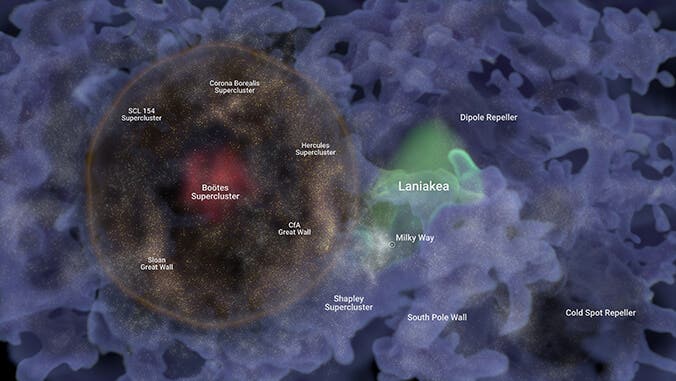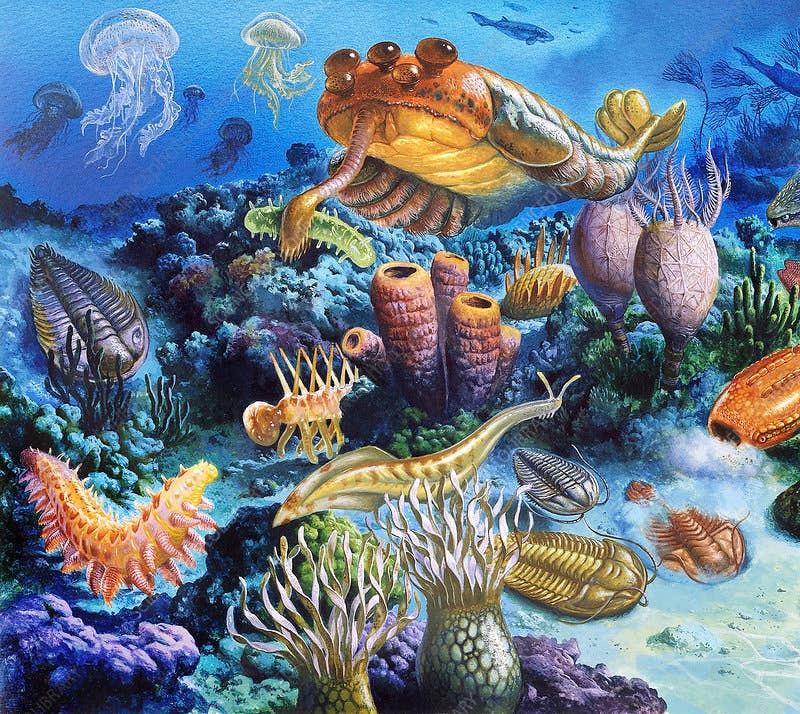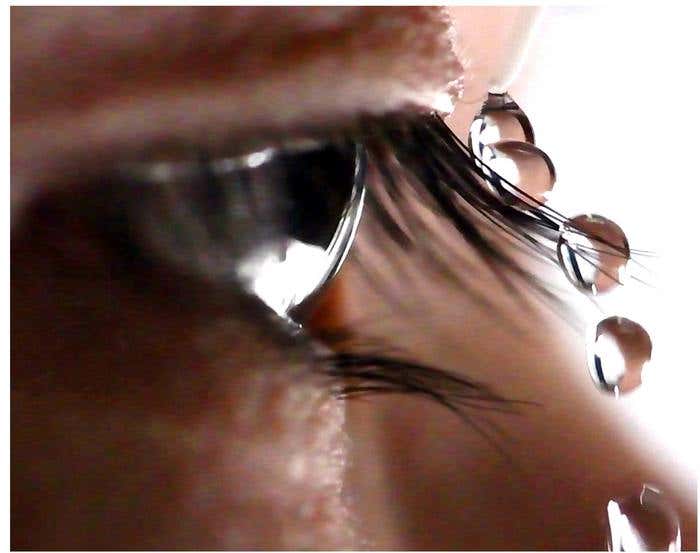Astronomers discover ‘bubble of galaxies’ a billion light years wide
A monumental finding by astronomers has just transformed our understanding of the universe’s architectural wonders.

[Sept. 10, 2023: Staff Writer, The Brighter Side of News]
Illustration of Hoʻoleilana. Red region (left) shows the enclosed shell with individual galaxies depicted as luminous tiny specks. Photo credit: Frédéric Durillon, Animea Studio; Daniel Pomarède, IRFU, CEA University Paris-Saclay. This work benefited from a government funding by France 2030 (CREDIT: P2I-Graduate School of Physics) under reference ANR-11-IDEX-0003.
A monumental finding by astronomers has just transformed our understanding of the universe's architectural wonders. Researchers have uncovered the existence of a "bubble of galaxies", an astonishing cosmic structure believed to be a fossilised footprint from the moments after the Big Bang. What makes this discovery even more breathtaking is its proximity to our home — it's right in our galactic backyard.
With a staggering span of a billion light years, this cosmic bubble is approximately 10,000 times the width of the Milky Way galaxy, our home. And while this might sound like an unfathomable distance, in the grand cosmic scale, it's merely a stone's throw away, situated just 820 million light years from us. This places the bubble within what astronomers term the "nearby universe."
To put things into perspective, Daniel Pomarede, an astrophysicist at France's Atomic Energy Commission, explained, "Think of the bubble as a spherical shell with a heart." At the core of this heart rests the Bootes supercluster of galaxies, encapsulated by an immense void sometimes referred to as "the Great Nothing".
Moreover, the shell is not an empty expanse; it comprises several galaxy superclusters, one of which is the well-documented Sloan Great Wall.
Related Stories
Pomarede’s recent publication in The Astrophysical Journal brings to light that this discovery wasn't just a eureka moment, but "part of a very long scientific process." Incredibly, this celestial revelation also provides validation to the theories proposed in 1970 by the distinguished US cosmologist, Jim Peebles, who later became a Nobel laureate in physics.
Peebles had introduced a radical concept: in the nascent universe, then a turbulent concoction of hot plasma, gravity, and radiation interactions produced sound waves termed as baryon acoustic oscillations (BAOs). As these waves navigated the plasma, they gave birth to bubbles.
About 380,000 years after the Big Bang, the universe began to cool, and the shape of these bubbles solidified. Ever since, as the universe has expanded, these bubbles have grown in size, much like other remnants from the post-Big Bang era.
Zoom of Figure 21 from Tully et al. (2023) in the galactic north sector showing the distribution of Cosmicflows-4 galaxy groups in supergalactic coordinates. (CREDIT: The Astrophysical Journal)
The science community had caught hints of BAOs back in 2005, analyzing data from proximate galaxies. However, this newly detected bubble is pioneering; it's the first recognized individual baryon acoustic oscillation, say the researchers.
A Lucky find
In a poetic nod to the bubble's significance, the astronomers baptized it "Ho'oleilana", translating to "sent murmurs of awakening" from a Hawaiian creation chant. This poetic moniker was proposed by the study's principal investigator, Brent Tully, an astronomer with affiliations to the University of Hawaii.
Top panel: supergalactic SGX−SGZ projection of all northern Cosmicflows-4 galaxies with 19,000
The bubble's discovery, however, was unforeseen. Tully, who was deeply engrossed in sifting through novel galaxy catalogues, stumbled upon it. "It was something unexpected," recollected Pomarede.
Elaborating further, Tully articulated that the size of Ho'oleilana is so colossal that "it spills to the edges of the sector of the sky that we were analysing." To understand this mammoth structure's form, the duo brought on board Australian cosmologist and BAO specialist, Cullan Howlett.
BAO detection using the BAO wavelet with different radii (rBAO) and widths (sBAO). The top panel of this figure shows the average values of the differences in the detection coefficient Br,s between the BAO and no-BAO simulations weighted by the variance. (CREDIT: The Astrophysical Journal)
With his mathematical prowess, Howlett discerned "the spherical structure which best corresponded to the data provided," recounted Pomarede. This pivotal contribution enabled the team to envisage Ho'oleilana's three-dimensional shape and locate the galaxy clusters nestled within.
Given the magnitude of this discovery, the cosmic horizon looks promising. Ho'oleilana may be the first of its kind discovered, but it is likely not the last.
Instruments like Europe's Euclid space telescope, which embarked on its voyage in July, offers an expansive cosmic viewpoint, boosting the chances of locating more such bubbles. Additionally, as Pomarede highlighted, the upcoming Square Kilometre Array — immense radio telescopes in the works in South Africa and Australia — will provide a unique visual perspective of galaxies from the Southern Hemisphere's vantage point.
In essence, the unveiling of Ho'oleilana has not just expanded our understanding of the universe but also promises a future filled with more celestial wonders waiting to be found.
Note: Materials provided above by The Brighter Side of News. Content may be edited for style and length.
Like these kind of feel good stories? Get the Brighter Side of News' newsletter.
Joseph Shavit
Head Science News Writer | Communicating Innovation & Discovery
Based in Los Angeles, Joseph Shavit is an accomplished science journalist, head science news writer and co-founder at The Brighter Side of News, where he translates cutting-edge discoveries into compelling stories for a broad audience. With a strong background spanning science, business, product management, media leadership, and entrepreneurship, Joseph brings a unique perspective to science communication. His expertise allows him to uncover the intersection of technological advancements and market potential, shedding light on how groundbreaking research evolves into transformative products and industries.



